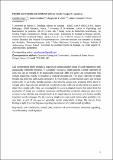Files in this item
Flexible use of simple and combined calls in female Campbell's monkeys
Item metadata
| dc.contributor.author | Coye, Camille | |
| dc.contributor.author | Ouattara, Karim | |
| dc.contributor.author | Arlet, Malgorzata E. | |
| dc.contributor.author | Lemmasson, Alban | |
| dc.contributor.author | Zuberbuhler, Klaus | |
| dc.date.accessioned | 2019-06-19T23:41:09Z | |
| dc.date.available | 2019-06-19T23:41:09Z | |
| dc.date.issued | 2018-07 | |
| dc.identifier | 252809400 | |
| dc.identifier | e5f792ad-33ca-47a7-8459-255fe6ced951 | |
| dc.identifier | 000439108800017 | |
| dc.identifier | 85048728890 | |
| dc.identifier | 000439108800017 | |
| dc.identifier.citation | Coye , C , Ouattara , K , Arlet , M E , Lemmasson , A & Zuberbuhler , K 2018 , ' Flexible use of simple and combined calls in female Campbell's monkeys ' , Animal Behaviour , vol. 141 , pp. 171-181 . https://doi.org/10.1016/j.anbehav.2018.05.014 | en |
| dc.identifier.issn | 0003-3472 | |
| dc.identifier.other | ORCID: /0000-0001-8378-088X/work/64360722 | |
| dc.identifier.uri | https://hdl.handle.net/10023/17930 | |
| dc.description | Research has been funded by the French Ministry of Research, the French University Institute (IUF), the National Agency for research (ANR ‘Orilang’) and the European Union's Seventh Framework Programme (FP7/2007-2013) / ERC grant agreement n° 283871 (prilang). | en |
| dc.description.abstract | Call combinations allow animals to expand the communicative power of small repertoires with acoustically inflexible elements. In Campbell's monkeys, Cercopithecus campbelli, males possess a small repertoire of calls that can be merged to an acoustically invariable suffix and which are concatenated into various sequences, mainly in response to external disturbances. The vocal repertoire of adult females has been less well studied although it is much richer, containing both alarm and various social calls. In particular, females possess a low-pitched contact call, produced either alone or merged with a high-pitched, arched unit. Combined contact calls are identity-richer and easier to detect than simple calls. Here, we investigated the socioecological factors that determined the production of single and combined utterances and found that combined utterances were more common when identity was relevant such as in mixed-species associations and during socially important vocal exchanges. In contrast, single calls were used mainly when predation risk was high, as part of this species' generally cryptic antipredator strategy. We discuss these finding in the light of current theories regarding the evolution of combinatorial signalling. | |
| dc.format.extent | 11 | |
| dc.format.extent | 732405 | |
| dc.language.iso | eng | |
| dc.relation.ispartof | Animal Behaviour | en |
| dc.subject | Call combination | en |
| dc.subject | Contact calls | en |
| dc.subject | Evolution of communication | en |
| dc.subject | Referential signalling | en |
| dc.subject | Vocal flexibility | en |
| dc.subject | Vocal signature | en |
| dc.subject | QH301 Biology | en |
| dc.subject | RC0321 Neuroscience. Biological psychiatry. Neuropsychiatry | en |
| dc.subject | NDAS | en |
| dc.subject.lcc | QH301 | en |
| dc.subject.lcc | RC0321 | en |
| dc.title | Flexible use of simple and combined calls in female Campbell's monkeys | en |
| dc.type | Journal article | en |
| dc.contributor.institution | University of St Andrews. School of Psychology and Neuroscience | en |
| dc.contributor.institution | University of St Andrews. Institute of Behavioural and Neural Sciences | en |
| dc.contributor.institution | University of St Andrews. Centre for Social Learning & Cognitive Evolution | en |
| dc.identifier.doi | https://doi.org/10.1016/j.anbehav.2018.05.014 | |
| dc.description.status | Peer reviewed | en |
| dc.date.embargoedUntil | 2019-06-20 |
This item appears in the following Collection(s)
Items in the St Andrews Research Repository are protected by copyright, with all rights reserved, unless otherwise indicated.

